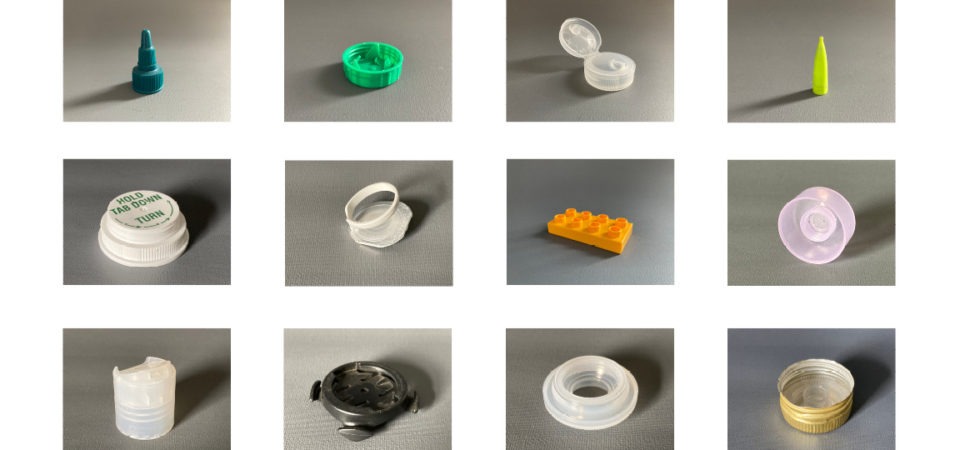The Wonders of Plastic, digital photographs with vinyl background, 2021
While most of us were under “stay at home” orders during the pandemic, the air became cleaner and the fuel consumption delightfully dropped. However, single-use plastic consumption soared with increased production, overuse and waste.
“COVID-19 triggered an estimated global use of 129 billion face masks and 65 billion gloves every month.” (Ford, 2020) During this time, I tried to imagine what role plastic would have in our lives ten years into the future. While many of my attempts as a parent and educator have been disappointing, I thought that perhaps by forecasting a more positive vision of the future I might be able to create motivation towards accomplishing change.
On New Year’s day, 2021, I started the digital project, The Wonders of Plastic, posting daily photographs of plastic lids, caps and tops on Instagram. With this enormous problem, I decided to concentrate on one small part of the puzzle with bite-size pieces. This focus allowed me to dive deeper into the complexity of the issue. While single-use plastic is convenient, my overarching question is, “Can most single-use plastic be eliminated from production and consumption by 2030?” This daily documentation unearthed the layered way these items are so threaded into our life. Ultimately, I keep wondering whether each item I examine is actually necessary or could be replaced.
Looking closely at the lids alone I began examining their properties. Right away I noticed that some of these caps have spinning powers while others curl, twist and glisten in the light. The plastic protective sealers that we peel off the lids are another added layer that have since replaced stickers or paper strips. My artwork has always been inspired by love/hate relationships and I find this similarly true with plastic. Spray bottles, bike bottle lids, pump dispenser lids, spout caps, hinged caps on a lid, and medicine child-proof caps – all of these are actually pretty cool inventions and maybe something we can’t live without.
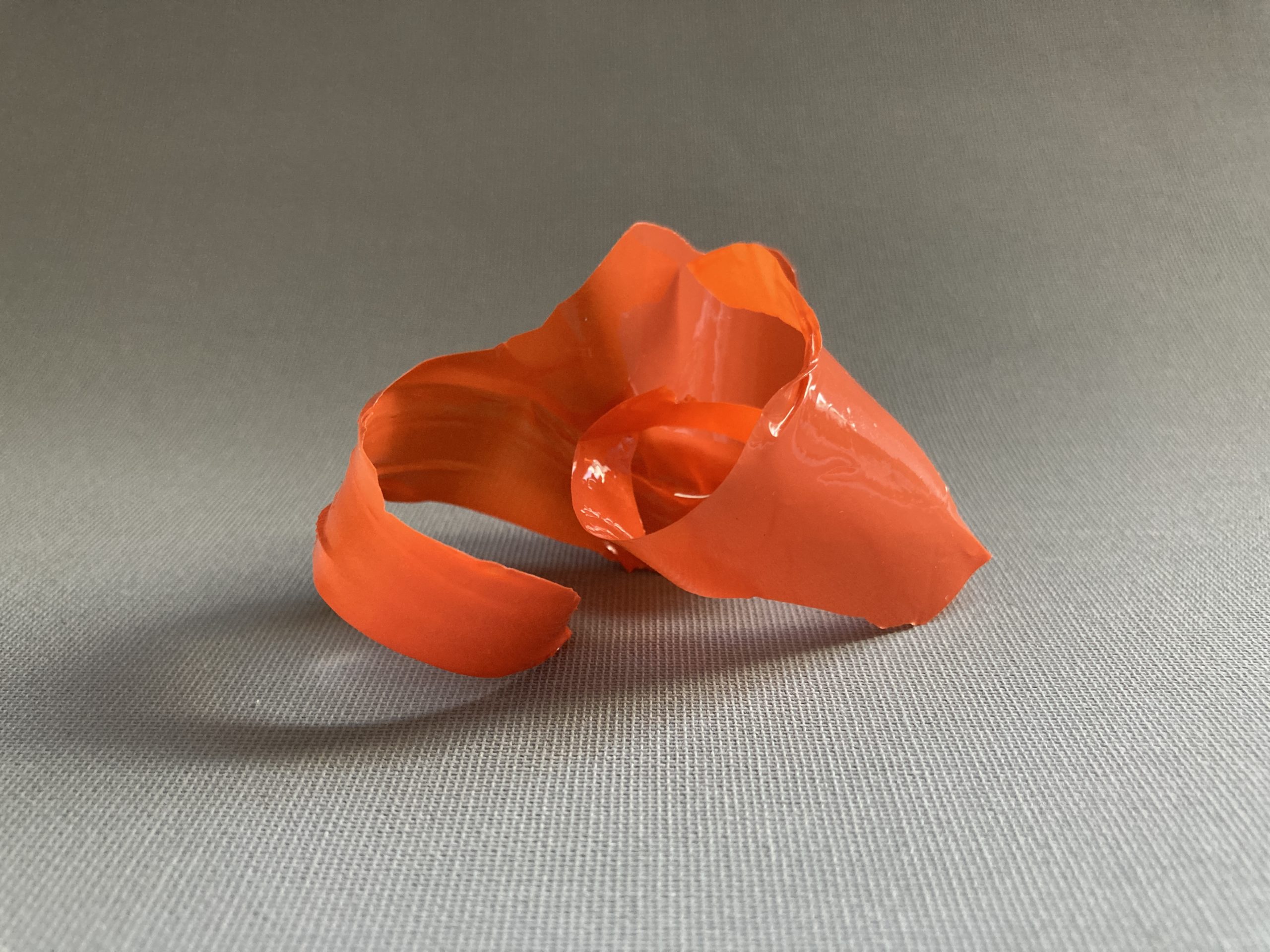
Wonders of Plastic (protective wrap for cap), Instagram post, 2021
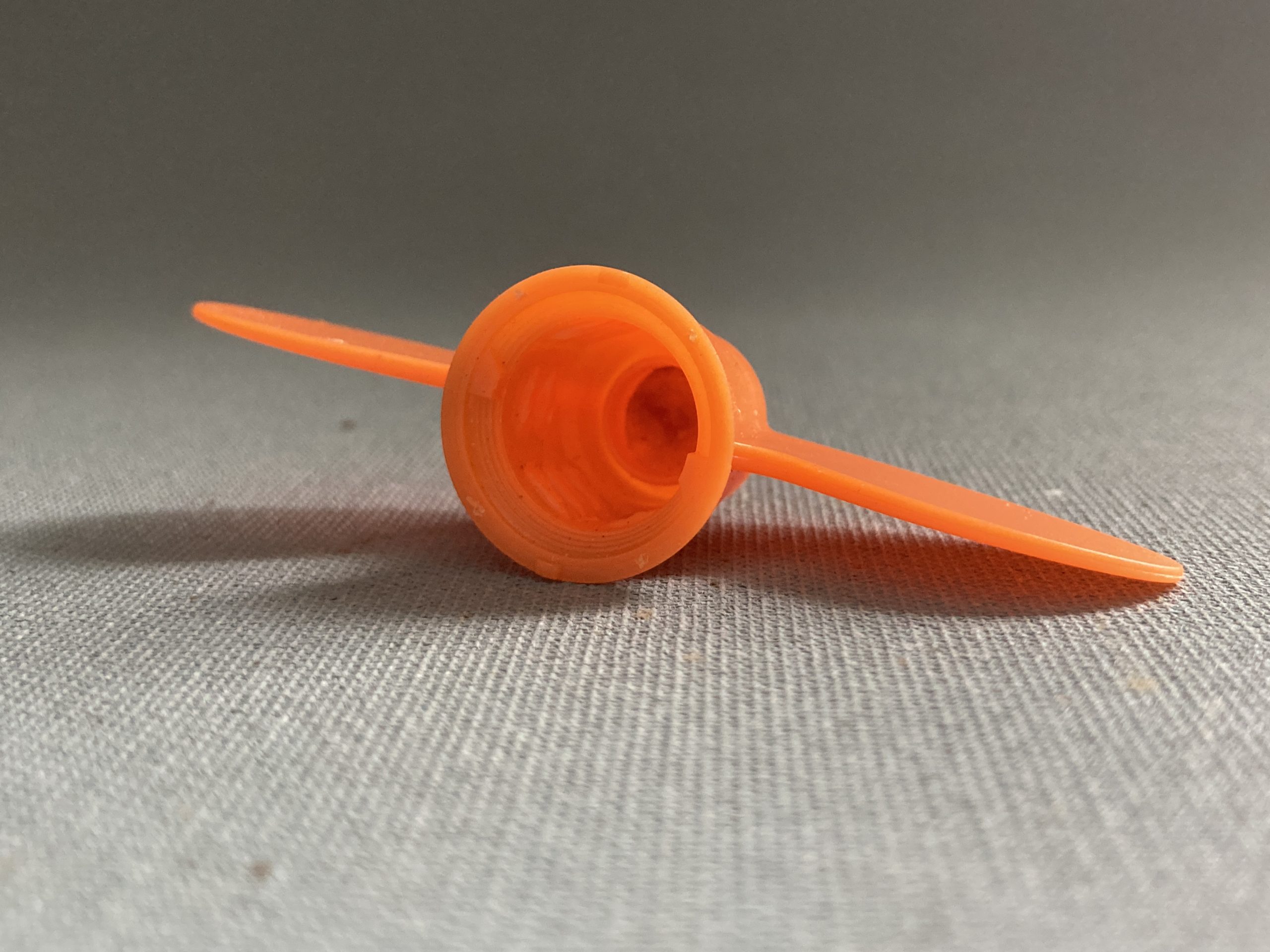
Wonders of Plastic (childproof cap), Instagram post, 2021
Another artwork that exposes our relationship with plastic that I stumbled upon was Robin Frohardt’s The Plastic Bag Store. This brilliant project used humor, playfulness and an immersive environment where everything including all the “fresh produce” is made from plastic bags. My recent work was also inspired by Pinar Yoldas’s An Ecosystem of Excess which, “asks a very simple question: ‘If life started today in our plastic debris filled oceans, what kinds of life forms would emerge out of this contemporary primordial ooze?’ The project introduces pelagic insects, marine reptilia, fish and birds endowed with organs to sense and metabolize plastics as a new Linnean order of post-human life forms.” (Yoldes, 2014)
Pinar Yoldes’s work is fantastical, futuristic, and somehow sad. Yet considering this idea of consuming plastic literally reminds me of my youth lying on the beach, collecting plastic nurdles in the sand and chewing on the salty plastic pellets until they were flattened. One of my happiest moments as a teenager was the warm sand, warm nurdles, warm chips with thinly grated melted cheddar cheese, on a beautiful Huntington Beach day where the calm surf gave us easy long rides. I wasn’t the only one chewing and collecting these nurdles, it was a local tradition.
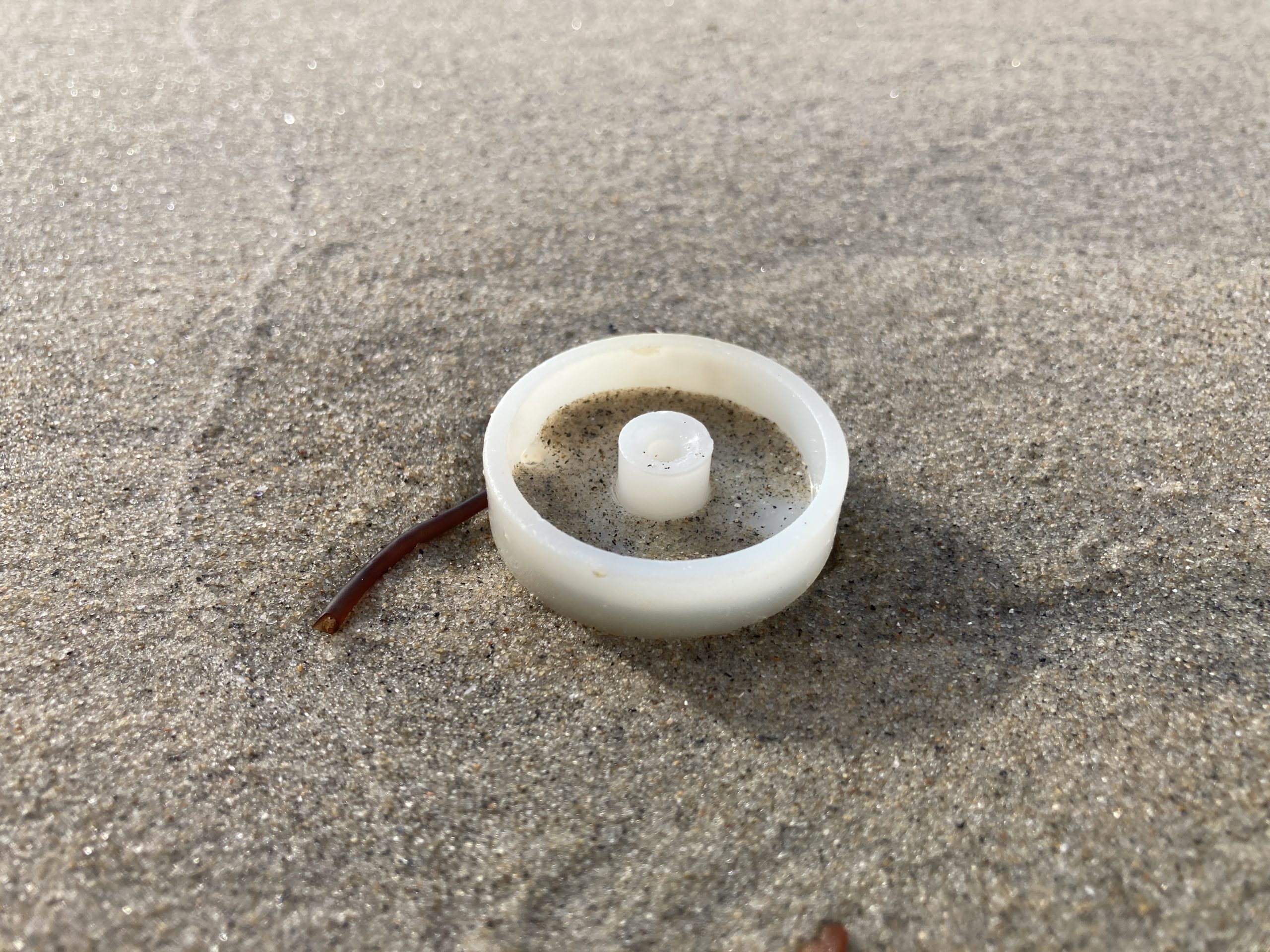
Plastic cap the size of a few hundred nurdles, photograph, 2021
Although I am concentrating on examining plastic caps, I couldn’t help being inspired by random street trash. A red ribbon twirled beautifully on the asphalt stopped me in my tracks one day. I photographed it and then carefully collected the ribbon to keep its shape. I have been preserving this and other plastic objects I find in plexiglass (plastic) museum dioramas with the photographs behind. I hope to capture both their beauty and disgust as visible reminders in the future of our present day. Perhaps this examination can bring more light on this issue that is often invisible with some plastics buried and burned or becoming microplastics in our air, water and stomachs.
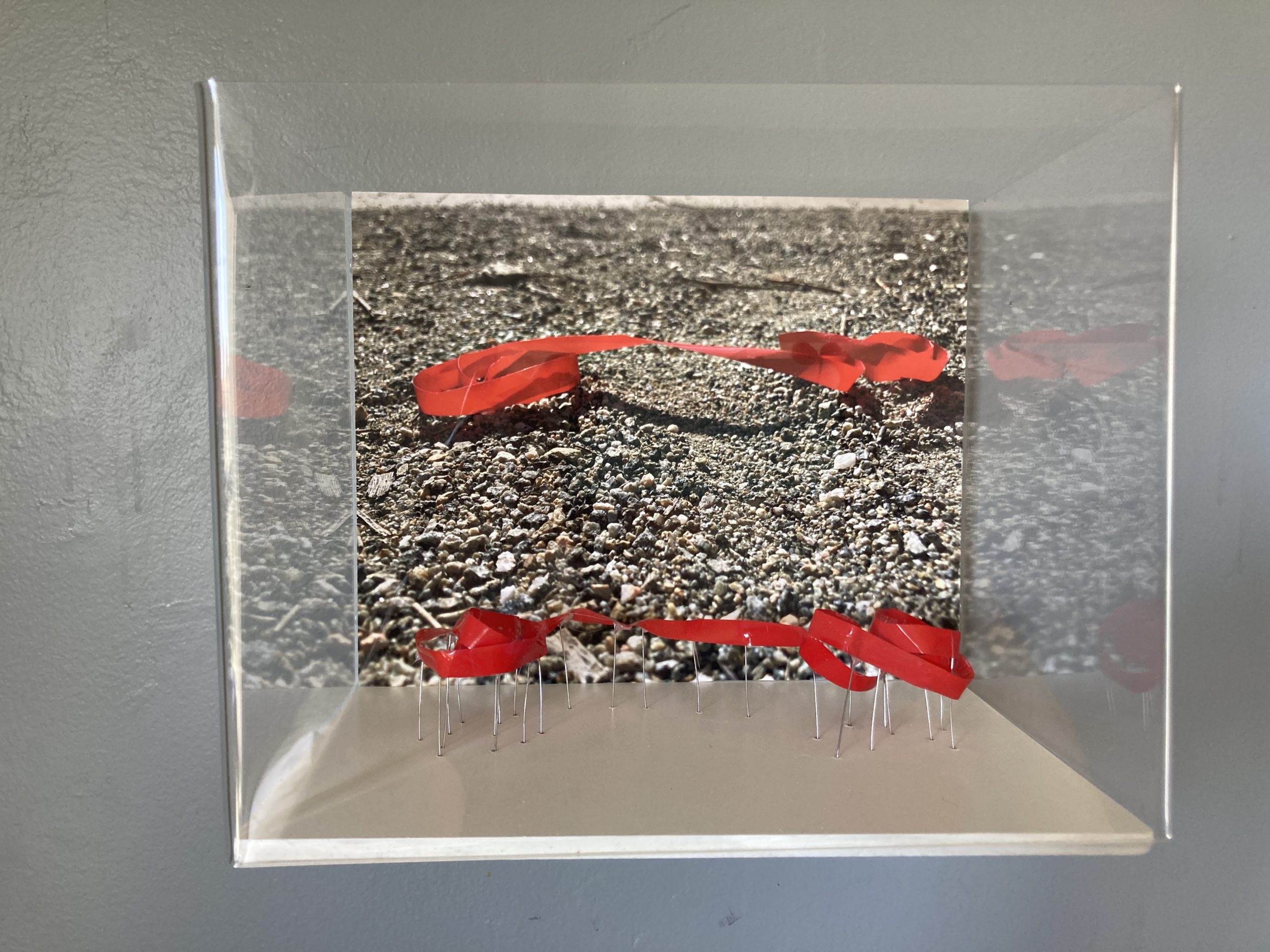
The Wonders of Plastic: Red Ribbon, 2021, Found ribbon, photo from iphone with plastic case, melamine, acrylic, metal pins, acrylic paint, 8.5 x 10 x 7
Looking back to 2007, when Annie Leonard created the online short documentary, The Story of Stuff, the thought of going plastic-free seemed like a daunting goal to achieve. While creating zero waste stations at a local elementary school, I saw the amount of individual glue sticks, markers, and pencils that were barely used and discarded. As my consciousness grew of our plastic consumption and knowledge of what really is plastic, the idea of “plastic-free” became ridiculous. In my naivety 10 years ago, I knew that single-use plastic was the main problem in creating a waste stream with devastating effects on the oceans and lands. However, I didn’t realize the extent of the problem – that plastic is also styrofoam, polyester, vinyl, and film, and used in filters in cigarettes, medical devices, electrical wires among many other uses that have helped civilization immensely. In the UN publication, Single-use Plastics: A Roadmap to Sustainability, it states, “Plastic is a miracle material. Thanks to plastics, countless lives have been saved in the health sector, the growth of clean energy from wind turbines and solar panels has been greatly facilitated, and safe food storage has been revolutionized.” (UNEP, 2018) The report doesn’t discuss that the production of plastics also causes CO2 emissions adding to climate change and pollution which mostly affects populations living near or downstream from factories. (Story of Plastic, 2021) What do we do with the plastic and fiberglass wind turbines after their roughly 30 year lifespan?
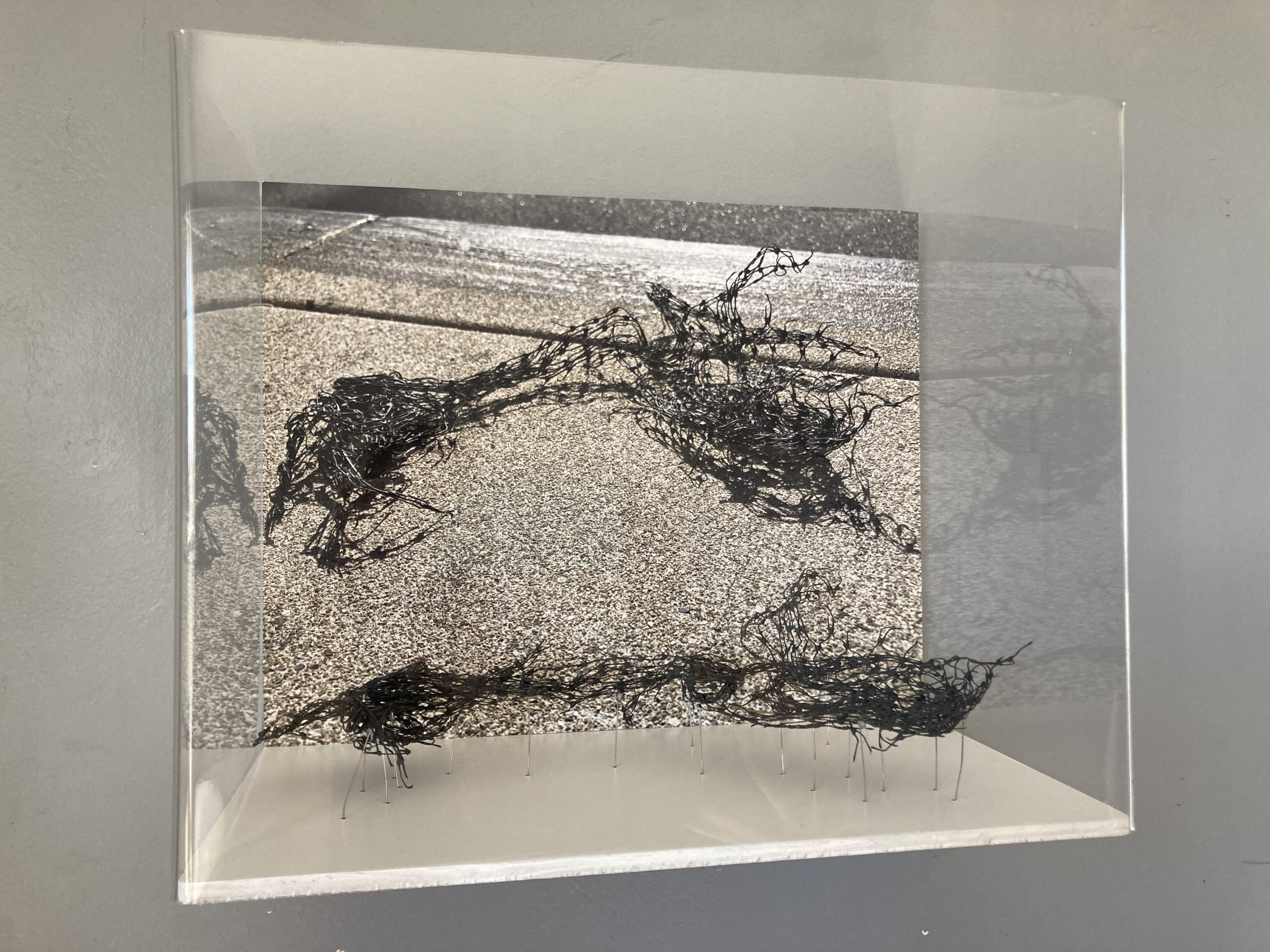
The Wonders of Plastic: Black Mesh, 2021
Found mesh, photo from iphone with plastic case, melamine, acrylic, metal pins, acrylic paint
11 x 13.5 x 8”
How do we make a new narrative around single-use plastics? The idea of reusing containers, popularizing refilling stations, endorsing bringing your own bag, buying bulk, etc. are obvious strategies for reducing single use, but still there are barriers and issues of inequity that impact people’s choices around plastic. Is plastic really cheaper? Certainly the argument of Annie Leanard that these “externalized costs” continue to be externalized. In fact, during Covid, many of these practices such as refilling your own cup or bringing your own bag were denied for reasons not backed up by science. Possible innovative solutions for greener packaging and products are coming everyday. Can technology save us? Although some seem good at first like bioplastics, they still don’t degrade quickly especially in the ocean and looking like a jellyfish can still be eaten.
I forcast by 2030 single-use plastic drinking bottles, plastic bags, and plastic disposable utensils will be on the edge of extinction. Other plastic containers will be replaced by glass and metal with refill stations more accessible. The US will catch-up to other parts of the world especially in Africa with laws banning single-use plastic. “The good news is that a growing number of governments are taking action and demonstrating that all nations, whether rich or poor, can become global environmental leaders. Rwanda, a pioneer in banning single-use plastic bags, is now one of the cleanest nations on earth. Kenya has followed suit, helping clear its iconic national parks and save its cows from an unhealthy diet.” (UNEP (2018). SINGLE-USE PLASTICS). My hope is that my cataloging of these items, perhaps not dissimilar to signage for the animals at the zoo, awakens people to a kind of extinction we might work toward in 2030.
References
Ford, David, (August 17, 2020) COVID-19 Has Worsened the Ocean Plastic Pollution Problem, Scientific American. https://www.scientificamerican.com/article/covid-19-has-worsened-the-ocean-plastic-pollution-problem/
UNEP (2018). SINGLE-USE PLASTICS: A Roadmap for Sustainability (Rev. ed., pp. vi; 6)
The Story of Plastic, https://www.youtube.com/watch?v=iO3SA4YyEYU)
The Plastic Bag Store, http://www.plasticbagstore.org
The Ecosystem of Excess, 2014
Terri Hughes-Oelrich is an artist residing in San Diego and an Associate Professor of Art at San Diego City College. She received her MFA degree from San Diego State University and a BA in Art Studio from the University of California, Santa Barbara. Her artwork has often been about the environment and she teaches sustainable art and design throughout her courses. She founded and directs the Sugar Museum since 2002, a non-profit virtual museum. Terri’s approach to researching sugar, sweeteners, additives and preservatives considers the climate impact of producing, consuming and disposing of these substances. For years, she worked to build a gardening, nutrition and environmental education program at Albert Einstein Academies. Her artwork has been shown in solo and group shows in Tijuana, Mexicali, and the US.
website: www.terrihughesart.com
Instagram @hughesoelrich
The MAHB Blog is a venture of the Millennium Alliance for Humanity and the Biosphere. Questions should be directed to joan@mahbonline.org
This article is part of the MAHB Arts Community‘s “Covid19 Diaries Series”. If you are an artist interested in sharing your thoughts and artwork, as it relates to the disrupted but defining period of time we live in, please contact Michele Guieu, Eco-Artist, and MAHB Arts Community coordinator: michele@mahbonline.org.
Thank you. ~

